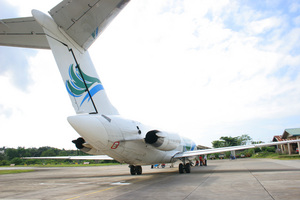 They used to service the small towns and rural areas where the large commercial airlines did not provide service, and some used the term “puddle jumpers” to refer to commuter or small, regional airline services. Today, as a result of the economy, mergers and some larger airline companies going belly up, regional airlines are a growing segment of the air transportation industry. However, many passengers, as well as the Federal Aviation Administration, are concerned that the safety standards of both the airplanes and the pilots that fly them may not be up to those of the big commercial carriers.
They used to service the small towns and rural areas where the large commercial airlines did not provide service, and some used the term “puddle jumpers” to refer to commuter or small, regional airline services. Today, as a result of the economy, mergers and some larger airline companies going belly up, regional airlines are a growing segment of the air transportation industry. However, many passengers, as well as the Federal Aviation Administration, are concerned that the safety standards of both the airplanes and the pilots that fly them may not be up to those of the big commercial carriers.
Almost half of all the flights in the country are operated by regional airlines, and they transport 160 million passengers per year – an increase of 40 percent since 2003. All of the major airlines, such as American, Delta, United, Continental, and US Airways utilize smaller regional carriers to fulfill their routes. Oftentimes, a passenger is unaware that when they purchase a ticket on a major carrier, they will actually be flying a “partner” airline, even though Federal law requires that disclosure. In most cases, regional carriers operate under the names or two-letter codes of the major airlines that hire them. Countless travelers are often surprised when they arrive at their departure gate and see a small, 50-seat aircraft when they were expecting a full-sized commercial jet. Today, it is not uncommon for smaller, regional jets to be used for longer flights than in years past, some for duration of three hours or more.
Some recent incidents involving regional airlines have caused Congress and government regulators to take notice. In February, a flight operated by Colgan Air, owned by a company called Pinnacle Airlines, crashed in Buffalo, New York, killing all 49 people on board, and one on the ground. Investigation of the accident unearthed that the pilots may have had inadequate training and actual flight hours, which may have been a major factor in how they reacted to the warning they received that the plane was about to stall due to icing conditions. The crash has served as a wake-up call for the FAA and those who police the air travel industry, bringing to light serious concerns about pilot training, compensation, hiring practices and even the number of hours a regional pilot and crew are working on each shift of duty. The major carriers require that a pilot applying to fly for them typically have 5,000 to 7,000 hours of flight time under their belts. With the commuter airlines, the standards are much lower – Colgan Air has a pilot on staff that was hired with less than 500 hours of flying time – and that wasn’t even the lowest number of hours among those in his new-hire training class. Captain Chesley “Sully” Sullenberger in his book Highest Duty: My Search for What Really Matters comments that, “Regional airlines will now take someone with 200 hours of flying experience and make him or her a first officer.”
Largely due to the information discovered after the crash in Buffalo, Congress passed a bill in October of this year that requires all new pilots hired by any airline have a minimum of 1,500 hours of flight time.
Poor Performers
Regional carriers routinely rank at the bottom of the Department of Transportation’s monthly reports on things like baggage handling, denied boarding and on-time performance.
Another area of concern is the fatigue factor – many regional pilots and co-pilots often commute long distances between their homes and the airports they fly out of, which can result in inadequate rest between flights. Roger Cohen, the president of the Regional Airline Association, a trade group, estimates that between 50 to 70 percent of pilots commute thousands of miles from the city where they were, in airline parlance, “domiciled”, in order to report for work. The stunning facts uncovered in the investigation of the Buffalo crash have shocked many people.
The spotlight is now focused on the strikingly low pay for new pilots; the rigors of flying multiple flights, at lower altitudes and thus often in worse weather than pilots on longer routes, while scrambling to get enough sleep; and the relative inexperience of pilots at the smaller airlines, whose training standards are the same, but whose skills may not be.
“Four of the six passenger flights that have crashed since September 11th, 2001, have been commuter flights,” points out PJ Scheiner, an experienced pilot and a personal injury attorney with the firm founded by his father almost four decades ago, Associates and Bruce L. Scheiner Personal Injury Lawyers, P.A. “As pilots ourselves, my father and I recognize the importance of stringent safety standards, extensive training and the amount of experience necessary to safely operate a commuter aircraft,” says Scheiner. “Our aviation experience makes us intimately familiar with the rigors of actually being in the cockpit.”
Aviation accident cases require in-depth expertise and a thorough knowledge of aircraft operation. If you or someone you love has been injured as a result of an airline accident, contact Associates and Bruce L. Scheiner, Personal Injury Lawyers at 1.800.Dial.BLS or log on to www.focusedonjustice.com
Associates and Bruce L. Scheiner, fighting for justice, and aggressively representing your legal rights.
 Florida Injury Lawyer Blog
Florida Injury Lawyer Blog





